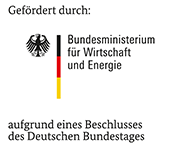283 ZBG / 1

Hochtemperaturofen in Betrieb
| Laufzeit: | 01.09.2008 - 28.02.2011 |
|---|---|
| Geldgeber: | Bundesministerium für Wirtschaft und Technologie über AiF |
| Bearbeiter: | Dr. Rick Durham |
| Arbeitsgruppe: | Hochtemperaturwerkstoffe |
In many industrial gasification and combustion processes highly corrosive conditions are encountered that make high demands on metallic components of the employed materials. Examples are plants for waste incineration, special refuse, bio mass, sludge etc. These charges contain high quantities of chlorine and sulphur compounds as well as heavy metals that have a strong corrosive effect based on attack from gaseous species and saline melts. To limit the extent of corrosive attack many plants are operated at relatively low temperatures, although operation at higher temperatures would be more desirable from an economic point of view, especially in waste incineration plants with regards to an increased degree of efficiency. Additionally, certain process temperatures are not allowed to fall below specific limits to comply with legal requirements of emission protection. The methods for protection against corrosion used so far like galvanic nickel-plating, overlay welding or thermal spraying of nickel based alloys or the use of compound tubes (high-alloyed tube casing on ferritic heat exchanger tubes) do not allow a significant increase of the process temperature above 400°C. In the field of waste incineration the demand for reliable, powerful capacity for incineration will rise due to the prohibition of the disposal of untreated waste, in force since July 2005 in Germany. Therefore the requirements for an efficient concept of corrosion protection that enable higher process temperatures combined with extended lifetime are growing.
A significant increase in tube wall temperatures in heat exchangers that are exposed to aggressive process media is only possible by the application of new concepts for protection. The combination of thermally sprayed coatings, (ASP (Arc SPraying) and HVOF (High Velocity Oxygen Fuel)) as well as overlay welding offers the potential for a significant enhancement in corrosion resistance.
The aim of the present investigation is to develop the arc spraying process into a form that is suitable for the application of corrosion resistant coatings to waste incineration equipment. Arc spraying has many advantages over other conventional coating processes, these being high coating application rate, relatively low process and investment costs and ease of transportability of the coating equipment. At the same time, the arc spraying process can deliver coatings that are relatively porous and with a large volume fractions of oxide inclusions which allow for easy ingress of chlorine to the substrate. Therefore, means to improve the coating application technique are an important target of this project, together with the development of coating systems suitable for application in waste incineration plant.
zurück
Das IGF-Vorhaben Nr. 283 ZBG / 1 der Forschungsvereinigung DECHEMA e.V., Theodor-Heuss-Allee 25, 60486 Frankfurt am Main wurde über die AiF im Rahmen des Programms zur Förderung der industriellen Gemeinschaftsforschung (IGF) vom Bundesministerium für Wirtschaft und Energie aufgrund eines Beschlusses des Deutschen Bundestages gefördert.
PD Dr. Mathias Galetz
Tel.: 069 / 7564-397
E-Mail: mathias.galetz
Abschlussbericht (pdf, 18,1 MB)